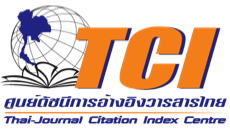การจัดการเรียนรู้เชิงรุกเพื่อพัฒนาสมรรถนะ การออกแบบกิจกรรมการเรียนรู้เชิงรุกของนักศึกษาครู (Active Learning for Develop Active Activity Design Competency of Teacher Students)
คำสำคัญ:
การจัดการเรียนรู้เชิงรุก, สมรรถนะการออกแบบกิจกรรมการเรียนรู้เชิงรุกบทคัดย่อ
งานวิจัยเรื่องนี้มีวัตถุประสงค์เพื่อศึกษา 1) สมรรถนะการออกแบบกิจกรรมการเรียนรู้เชิงรุก ของนักศึกษาครู 2) ความคิดเห็นของนักศึกษาที่มีต่อการจัดการเรียนรู้เชิงรุกเพื่อพัฒนาสมรรถนะ การออกแบบกิจกรรมการเรียนรู้เชิงรุกของนักศึกษาครู กลุ่มตัวอย่างที่ใช้ในการวิจัยครั้งนี้ คือ นักศึกษาระดับปริญญาตรีชั้นปีที่ 2 ที่ลงทะเบียนในรายวิชาการจัดการเรียนรู้และการจัดการชั้นเรียน กลุ่มที่ 1 จำนวน 31 คน ได้มาจากการสุ่มแบบแบ่งกลุ่ม (Cluster Random Sampling) เครื่องมือที่ใช้ในการวิจัยประกอบด้วย 1) แผนการจัดการเรียนรู้ 2) แบบประเมินการออกแบบกิจกรรมการเรียนรู้เชิงรุก 3) แบบสอบถามความคิดเห็น การวิจัยครั้งนี้เก็บรวบรวมข้อมูลทั้งเชิงปริมาณและคุณภาพ วิเคราะห์ข้อมูลโดยใช้สถิติ ค่าเฉลี่ย ส่วนเบี่ยงเบนมาตรฐาน ค่าร้อยละ และการวิเคราะห์เชิงเนื้อหา ผลการศึกษาพบว่า 1) สมรรถนะการออกแบบกิจกรรมการเรียนรู้เชิงรุกของนักศึกษาครูหลังการจัดการเรียนรู้เชิงรุก ภาพรวมอยู่ในระดับ มากที่สุด 2) ความคิดเห็นของนักศึกษาที่มีต่อการจัดการเรียนรู้เชิงรุกเพื่อพัฒนาสมรรถนะการออกแบบกิจกรรมการเรียนรู้เชิงรุกของนักศึกษาครู อยู่ในระดับ มากที่สุด
เอกสารอ้างอิง
Bonwell, C. C., & Eison, J. A. (1991). Active Learning: Creating Excitement in the Classroom 1991 ASHE-ERIC Higher Education Reports. Washington, DC: Office of Educational Research and Improvement (ED).
Campbell, E.; & Piccinin, S. (1999). Active Learning. In Centre for University Teaching Technologies, University of Ottawa. Retrieved July 5, 2008, from http://www.uottawa.ca/academic/cut/options/Feb_99/ActiveLearning_en.htm.
Duangpraget, N. (2019). Problem-Based Active Learning Model on Non-formal Education Students’ Academic Competence. [Online]. Retrieved June 20, 2020, from http://ejournals.swu.ac.th/index.php/jedu/article/view/9862. (in Thai)
Meyers, Chet; & Jones, Thomas. B. (1993). Promoting Active Learning: Strategies for the College Classroom. San Francisco: Jossey-Bass.
Moolkam, S. and et all., (2006). Writing lesson Plan in Thinking. 2nd ed. Bangkok: Pappim Limited Partnership. (in Thai)
Nillapun, M. (2015). Research Methodology in Education. 8 th ed. Nakhon Pathom: Research and Educational Development Center, Faculty of Education, Silpakorn University. (in Thai)
Office of the Higher Education Commission. (2009). Thai Qualifications Framework for Higher Education. [Online]. Retrieved July 26, 2020, from http://www.mua.go.th/users/tqf-hed/news/FilesNews/FilesNews3/News328072552.pdf. (in Thai)
Panklum, A., Suwanjarean, T. and Tangnara, C., (2017). The Effect of Using Active Learning to Promote English Speaking Skill for Pre-Service Teachers. [Online]. Retrieved July 26, 2020, from https://research.kpru.ac.th/sac/fileconference/24542018-05-01.pdf. (in Thai)
Patrakorn, S. (2009). The Effects of Organizing Active Learning on Problem Solving and Mathematical Communication Abilities of Mathayomsuksa III Students in Probability. Master of Education. Thesis Program in Secondary Education at Srinakharinwirot University. (in Thai)
Phuangphae, P. (2019). “A Development of Instructional Activities Model Based on Constructivist Theory and Active Learning For Student Teachers to enhance Social Studies Teachers Competencies”. Veridian E-Journal, Silpakorn University 11(2): 1-2. (in Thai)
Phusitrattanawalee, P. (2017). “Active Learning Instructional Model of Teachers in Southern College Technology”. Journal of Southern Technology 10(1): 1. (in Thai)
Pornthadawit, N. (2017). “Development of Active Learning in Learning Management Subject”. UTK Research Journal 11(1): 1-2. (in Thai)
Raksuthee, S. and et all., (2003). Handbook: Writing lesson Plan. Bangkok: PattanasuKsa. (in Thai)
Ruangsuwan, C. (2010). Active Learning. [Online]. Retrieved June 26, 2020, from https://www.pharmacy.cmu.ac.th/unit/unit_files/files_download/2011-06-2211-53-Active%20%20Learning.doc. (in Thai)





